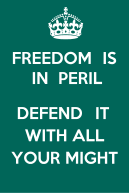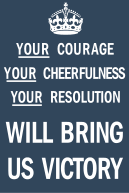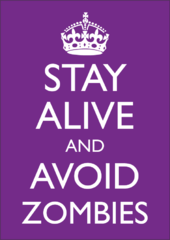Keep Calm and Carry On

Keep Calm and Carry On was a motivational poster produced by the British government in 1939 in preparation for the Second World War. The poster was intended to raise the morale of the British public, threatened with widely predicted mass air attacks on major cities.[1][2] Although 2.45 million copies were printed, and although the Blitz did in fact take place, the poster was hardly ever publicly displayed and was little known until a copy was rediscovered in 2000 at Barter Books, a bookshop in Alnwick. It has since been re-issued by a number of private companies, and has been used as the decorative theme for a range of products.[3]
A memorable evocation of Victorian stoicism—the “stiff upper lip” self-discipline, fortitude and remaining calm in adversity, which popular culture rendered into a British character trait, the poster has become internationally recognised around the world.[4] It was thought that only two original copies survived until a collection of approximately 15 was brought in to the Antiques Roadshow in 2012 by the daughter of an ex-Royal Observer Corps member.[5]
History
Design and production


The Keep Calm and Carry On poster was designed by the Ministry of Information during the period 27 June to 6 July 1939.[6] It was produced as part of a series of three "Home Publicity" posters (the others read "Your Courage, Your Cheerfulness, Your Resolution Will Bring Us Victory" and "Freedom Is in Peril / Defend It With All Your Might"). Each poster showed the slogan under a representation of a "Tudor Crown" (a symbol of the state). They were intended to be distributed to strengthen morale in the event of a wartime disaster, such as mass bombing of major cities using high explosives and poison gas, which was widely expected within hours of an outbreak of war.[2]
A career civil servant named A.P. Waterfield came up with "Your Courage" as "a rallying war-cry that will bring out the best in everyone of us and put us in an offensive mood at once".[2]
Detailed planning for the posters had started in April 1939 and the eventual designs were prepared after meetings between officials from the Ministry of Information and HM Treasury on 26 June 1939 and between officials from the Ministry of Information and HMSO on 27 June 1939.[6] Roughs of the poster were completed on 6 July 1939, and the final designs were agreed by the Home Secretary Samuel Hoare, 1st Viscount Templewood on 4 August 1939. Printing began on 23 August 1939, the day that Nazi Germany and the USSR signed the Molotov–Ribbentrop Pact, and the posters were ready to be placed up within 24 hours of the outbreak of war.[6]
Almost 2,500,000 copies of Keep Calm and Carry On were printed between 23 August 1939 and 3 September 1939 but the poster was not sanctioned for immediate public display. It was instead decided that copies of the poster should remain in "cold storage" for use after serious air raids (with resources transferred to Your Courage and Freedom is in Peril). Copies of Keep Calm and Carry On were retained until April 1940, but stocks were then pulped as part of the wider Paper Salvage campaign.[6] An October 1940 edition of the Yorkshire Post records the poster being hung in a shop in Leeds.[7]
The remainder of the Ministry of Information publicity campaign was cancelled in October 1939 following criticism of its cost and impact. Many people claimed not to have seen the posters; while those who did see them regarded them as patronising and divisive.[8] Design historian Susannah Walker regards the campaign as "a resounding failure" and reflective of a misjudgement by upper-class civil servants of the mood of the people.[9]
The typeface is often assumed to be Gill Sans,[10] which is very close but not exact (see the terminals of the 'C', for example). The lettering was perhaps hand drawn by a now-unknown designer.[11][12]
Later developments
In late May and early June 1941, 14,000,000 copies of a leaflet entitled "Beating the Invader" were distributed with a message from Prime Minister Winston Churchill. It begins "If invasion comes..." and exhorts the populace to "Stand Firm" and "Carry On". The two phrases do not appear in one sentence, as they applied to different segments of the population depending on their circumstances, with those civilians finding themselves in areas of fighting ordered to stand firm (i.e., stay put) and those not in areas of fighting ordered to carry on (i.e., continue vital war work). Each mandate is identified as a "great order and duty" should invasion come. The leaflet then lists 14 questions and answers on practical measures to be taken.[13]
Rediscovery and commercialisation

In 2000, Stuart Manley, co-owner with his wife Mary of Barter Books Ltd. in Alnwick, Northumberland, was sorting through a box of used books bought at auction when he uncovered one of the original "Keep Calm and Carry On" posters. The couple framed it and hung it up by the cash register; it attracted so much interest that Manley began to produce and sell copies.[14] Other companies followed suit, and the design rapidly began to be used as the theme for a wide range of products.[15] Mary Manley later commented, "I didn't want it trivialised; but of course now it's been trivialised beyond belief."[15]
In early 2012, Barter Books debuted an informational short film, The Story of Keep Calm and Carry On, providing visual insight into the modernisation and commercialisation of the design and the phrase.[16]
A memorable evocation of British stoicism—the “stiff upper lip” self-discipline, fortitude and remaining calm in adversity, Susannah Walker comments that the poster is now seen "not only as a distillation of a crucial moment in Britishness, but also as an inspiring message from the past to the present in a time of crisis".[17] She goes on to point out, however, that such an interpretation overlooks the circumstances of its production, and the relative failure of the campaign of which it formed a part.[17]
Trademark claims
In August 2011, it was reported that a UK-based company called Keep Calm and Carry On Ltd[18] had registered the slogan as a community trade mark in the EU, CTM No: 009455619 and also in the United States No: 4066622.[19][20] after failing to obtain registration of the slogan as a trademark in the United Kingdom.[21] They issued a take-down request against a seller of Keep Calm and Carry On products.[22][23] Questions have been raised as to whether the registration could be challenged, as the slogan had been widely used before registration and is not recognisable as indicating trade origin.[20] An application has been submitted by British intellectual property advisor and UK trademarking service Trade Mark Direct, to cancel the registration on the grounds that the words are too widely used for one person to own the exclusive rights,[24] but the request for cancellation was rejected and the trade mark is still protected in all EU countries. The company subsequently tried to register the slogan as its trademark in both the United States[25] and Canada.[21][26]
Imitations

As the popularity of the poster in various media has grown, innumerable parodies, imitations and co-optations have also appeared, making it a notable meme. Messages range from the cute to the overtly political, typically with references to other aspects of popular culture ranging from the royal wedding of Kate Middleton and Prince William to the Super Mario video games. Examples have included "Now Panic and Freak Out" (with an upside-down crown), "Get Excited and Make Things" (with a crown incorporating spanners), "Keep Calm and Have a Cupcake" (with a cupcake icon), "Don't Panic and Fake a British Accent", "Keep Calm and Hate Apple" (with the Windows logo), "Keep Calm and Hate Microsoft" (with the Apple logo), "Keep Clam and Gary On" (a SpongeBob SquarePants-themed parody), "Keep Calm and Call Batman" (with the Batman logo),[27] "Keep Calm and Switch to Linux" (with Tux)[28] and "Keep Spending and Carry On Shopping".[29] In March–April 2012, the British pop-rock band McFly undertook a theatre tour entitled "The Keep Calm and Play Louder Tour", promoted with a poster closely based on that of 1939. In late 2012 and early 2013, the "Save Lewisham Hospital" campaign (a protest against proposed cuts in services at University Hospital Lewisham) made widespread use of a poster with the slogan "Don't Keep Calm Get Angry and Save Lewisham A&E".[30][31] Shepherd Neame Brewery put the slogan "Keep Calm and Celebrate" on the bottles of their Spitfire ale, which was designed to commemorate the Battle of Britain. The historic railroad town of Helper, Utah, uses the theme, "Keep Calm and Visit Helper," as part of its arts renaissance promotion.
Calgary (Alberta, Canada) Mayor Naheed Nenshi's efforts to encourage and motivate his citizens in the wake of the 2013 Alberta floods have made his name the subject of parody "Keep Calm and Nenshi On" fundraising T-shirts.[32]
See also
- British propaganda during World War II
- Stiff upper lip
- We Can Do It!, an American World War II poster that was also rediscovered years later
References
- ↑ Richard Slocombe, British Posters of the Second World War (London: Imperial War Museum, 2012), p. 6
- 1 2 3 Lewis, Rebecca, PhD (5 April 2009). "1939: The Three Posters (PhD Extract)". Keep Calm and Carry on and other Second World War Posters: British Home Front Propaganda Posters of the Second World War.
- ↑ Hughes, Stuart (4 February 2009). "The Greatest Motivational Poster Ever?". BBC News.
- ↑ "Keep calm and carry on … bidding for rare poster". The Guardian. 2 October 2016.
- ↑ Slack, Chris (23 February 2012). "Keep Calm and Carry On... to the bank: Original wartime poster shows up on Antiques Roadshow". Daily Mail. London. Retrieved 13 May 2012.
- 1 2 3 4 Irving, Henry (27 June 2014). "Keep Calm and Carry On – The Compromise Behind the Slogan". History of Government Blog. Retrieved 27 June 2014.
- ↑ "Ban on Silk Stockings: Should They Have Been Rationed?". Yorkshire Post and Leeds Mercury. 22 October 1940. p. 4. Retrieved 17 November 2014.
- ↑ Rees, Nigel (20 July 2011). "Cheer up, the worst is yet to come". Today programme. BBC Radio 4.
- ↑ Walker 2012, pp.6–7.
- ↑ "Keep Calm and Carry On: Fonts". K-Type. Retrieved 28 September 2014.
- ↑ Henry, Richard. "What font did the UK Ministry of Information use on the "Keep Calm and Carry On" poster?". Quora.com. Retrieved 28 September 2014.
- ↑ Kominek, Lex. "KEEP CALM AND CARRY ON - WWII Posters". Typophile. Retrieved 28 September 2014.
- ↑ "IF INVASION COMES. MR. CHURCHILL'S ORDERS. "Stand Firm and Carry On."". The West Australian. Perth, WA, Australia. 26 May 1941. p. 6.
- ↑ "About Keep Calm and Carry On".
- 1 2 "Keep Calm and carry on ... into a feud". The Sydney Morning Herald. 4 May 2013. Retrieved 4 May 2013.
- ↑ "The Story of Keep Calm and Carry On" on YouTube
- 1 2 Walker 2012, p. 45.
- ↑ "Keep Calm and Carry On Ltd". Keepcalmandcarryon.com. Retrieved 24 February 2014.
- ↑ Bustillos, Maria (5 October 2011). "The Vicious Trademark Battle Over 'Keep Calm and Carry On'". The Awl.
- 1 2 Phillips, Jeremy (22 August 2011). "Monday miscellany". IPKitten blog.
- 1 2 Rayner, Gordon (24 September 2011). "Battle rages over 'Keep Calm and Carry On' souvenirs". The Daily Telegraph. London.
- ↑ "Battle over trademark of 'keep calm' phrase". BBC News Online. 22 September 2010. Retrieved 22 September 2011.
- ↑ "Keep calm and carry on items removed from my ebay account". justanswer.com. August 2011.
- ↑ "IP group aims to reclaim 'Keep Calm & Carry On'". freelanceuk.com.
- ↑ "Serial Number: 85297485 Keep Calm and Carry On USA Trademark". Official Gazette. USPTO. 20 September 2011.
- ↑ "Canadian Trade-mark Data". IC.GC.CA. 13 October 2011.
- ↑
- ↑ "Keep calm and switch to Linux.".
- ↑ Walker, Rob (5 July 2009). "Remixed Messages". The New York Times Magazine. Retrieved 21 March 2012.
- ↑ Little, Mandy (21 December 2012). "Protestors show unity". South London Press. London. Retrieved 27 January 2013.
- ↑ "Save Lewisham Hospital!". Save Lewisham Hospital campaign. 2013. Retrieved 27 January 2013.
- ↑ Dean Bennett (28 June 2013). "Mayor Nenshi has captured Calgary's heart, but the worst, at least politically, is yet to come". Toronto: The Globe and Mail. Retrieved 24 February 2014.
Further reading
- Clampin, David (2009). ""To Guide, Help and Hearten Millions": the place of commercial advertising in wartime Britain, 1939–1945". Journal of Macromarketing. 29 (1): 58–73. doi:10.1177/0276146708328054.
- Inkster, Nigel; Nicoll, Alexander (2010). "Keep Calm and Carry On". Survival: Global Politics and Strategy. 52: 249–256. doi:10.1080/00396331003764777.
- Lewis, Bex (2012). "The Renaissance of 'Keep Calm and Carry On'". The Poster. 2: 7–23. doi:10.1386/post.2.1.7_1.
- Walker, Susannah (2012). Home Front Posters of the Second World War. Oxford: Shire. ISBN 9780747811428.
External links
| Wikimedia Commons has media related to Keep calm and carry on. |
- Photographs displaying examples of the poster's popularity, as printed in The Guardian
- Photo of the original poster on the Barter Books website
- First person: 'I am the Keep Calm and Carry On man'
- Dr Bex Lewis, Original history of the poster, and blog tracing its 21st Century renaissance
- Video explaining the basic history of the poster
- Popular Keep Calm Posters